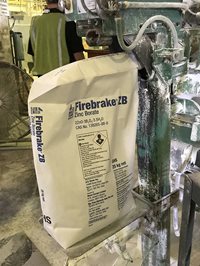On November 6, 1961, one of the most costly and destructive residential fires in California history ignited. Especially dry conditions and strong Santa Ana winds (blowing up to 50 miles per hour) accelerated the fire’s spread.
Called the “Bel Air Fire,” this nightmare ripped through one of the most high-profile neighborhoods in the country, home to several famous actors and even then Vice President Richard Nixon. In total, the fire destroyed 484 homes and burned more than 6,000 acres.
U.S. Borax played an instrumental role in stopping the fire by supplying powdered borate ore to firefighting crews for a flame-retardant mixture. The crews added water to the borate, then loaded it onto repurposed B-17 bombers. Nicknamed “Borate Bombers,” pilots flew these planes over the fire and dropped the compound to curb its spread. Firefighters eventually controlled the flames and extinguished the fire two days later.

Photo by Grey Villet
Afterwards, the city of Los Angeles enacted several laws and fire safety policies, including banning wood shingle roofs.
While these measures were overdue, they fell short of addressing the underlying problem: Highly combustible materials surrounding people needed an effective flame retardant.
This need drove our researchers into action. We started testing formulations, looking for a compound that could prevent and mitigate fire damage. After a decade of research and development, we released our first zinc borate fire retardant, Firebrake®, into the market.
Boron’s use as a flame retardant
One of the earliest uses of boron as a flame retardant was in the 18th century when Obadiah Wyld patented a mixture for flame retardant clothing.
During the mid-20th century, firefighters used borate powder mixed with water to combat wildfires before eventually replacing it with an ammonium phosphate compound.
After the Bel Air Fire revealed the inherent flammability risk of common materials, we started researching how to create a new boron flame retardant to protect and mitigate fire damage.
In 1972, we released our groundbreaking product Firebrake ZB, a zinc borate additive to enhance the effectiveness of flame-retardant formulations for several products—both cellulosic and polymeric based.
 Firebrake ZB hit the market at the right time. In 1973, the National Commission on Fire Prevention and Control released a major report called America Burning, which showed how much damage fire caused annually. Compiled from a two-year study, the report estimated fires caused 12,000 deaths, 300,000 serious injuries, and $11.4B (USD) in property damage each year. The report grabbed the public’s attention, causing widespread concern about fire safety and prevention.
Firebrake ZB hit the market at the right time. In 1973, the National Commission on Fire Prevention and Control released a major report called America Burning, which showed how much damage fire caused annually. Compiled from a two-year study, the report estimated fires caused 12,000 deaths, 300,000 serious injuries, and $11.4B (USD) in property damage each year. The report grabbed the public’s attention, causing widespread concern about fire safety and prevention.
During this time, the U.S. was also experiencing a severe energy shortage. The shortage caused increased demand for energy-saving products such as insulation, a highly combustible material. To make insulation more fire retardant, manufacturers applied Firebrake ZB.
Firebrake is still a popular product among insulation manufacturers today, not only for fire retardancy but also for its ability to enhance insulation’s effectiveness by increasing infrared radiation absorption.
But zinc borates offer more benefits than fire retardancy specific ones such as inhibiting flame combustion and promoting char formation. Zinc borates also:
- Suppress smoke formation and afterglow
- Are halogen-free
- Have synergistic effect with other flame-retardant additives
- Act as anti-tracking agents
- Enhance corrosion resistance
- Boost UV protection
- Promote adhesion with metals
- Are used as wood preservatives in wood and wood plastics composites (sold as Borogard® ZB by U.S. Borax)
Anhydrous zinc borate fire retardant
While Firebrake ZB excels in most fire-retardant formulations, specialized industries process polymers at very high temperatures. Controlling the rate of heat release in moisture-sensitive processing is a main concern for these manufacturers.
Responding to their needs, we developed Firebrake 500, the first anhydrous zinc borate product, in 1995. This borate product features unprecedented thermal stability, no water of hydration, and is stable up to 600° C.
Zinc borates’ growth in fire retardant polymers
Today, our fire retardancy researchers continue to build upon an already large body of knowledge. We see the exciting opportunities for boron flame retardants in the polymer industry.
Polymers are everywhere, and zinc borates are an effective, safe additive found in all types of polymer systems—working in both halogen and halogen-free formulations.
Even a small concentration of borates can enhance manufacturers’ formulations, enabling them to pass common fire safety standards such as UL94.
Many modern polymer manufacturers are looking to move to halogen-free products, such as zinc borates, which eliminate toxic fumes when a polymeric material combusts.
Need help with your boron flame retardant formulation?
Come to the experts that developed borate flame retardants. Your products and formulations will benefit from our decades of ground-breaking research. Our technical team includes leading researchers who can help you develop an effective flame retardant formulation.
Whether you’re experiencing processing challenges, have questions about particle size offering, or need guidance on regulatory concerns, U.S. Borax can support your needs.
Resources